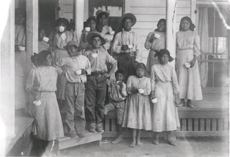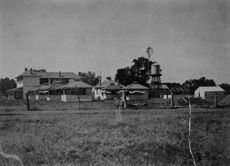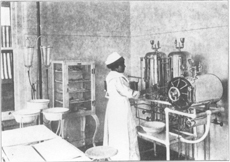Indian School Hospitals Under the
Office of Indian Affairs (c.1883-c.1916)
Off-reservation boarding schools were considered by many government and boarding school officials to be major successes in forcing Native American children to adopt the ways of white "civilization" and simultaneously to abandon their own Native traditions. Carlisle Indian School in Carlisle, Pennsylvania, was a school of this type, as was Sherman Institute in Riverside, California. Native children were originally brought to Carlisle as hostages to insure that their parents would not continue armed resistance against the United States Army.
However, many of the first Carlisle students became ill from diseases, such as tuberculosis, and died in the school's opening years. This may be a reason for Carlisle President Richard H. Pratt's letter to a physician in 1884, requesting help in selecting "healthy children" for the school from Indian reservations in the West. This letter is displayed here.
In addition to providing medical treatment to its students, Carlisle Indian School Hospital also functioned as a preliminary nurse training facility, preparing Native American women to move on to regular nursing schools, as the souvenir album here shows.
Exhibit Case 3

Group picture at the Tuberculosis Sanitorium, Phoenix Indian School, Phoenix, Arizona, c. 1890-1910
Courtesy National Archives and Records Administration

Tuberculosis Sanitorium buildings, Phoenix Indian School, Phoenix, Arizona, (c.1890-1910)
Courtesy National Archives and Records Administration
The work of the schools, then, in the words of their chief, is "to teach the children to know, in order that they may know how to live right." Right living is the only road to long living, or to useful living, and the hygiene of the school room, the dormitory and the workshop is of more vital importance to the Indian child than to the child of any race further advanced in civilization, and hence of greater physical stamina. The tendency of the Indian to consumption must not for a moment be forgotten in this stress of his transition period. The foundation of a sound constitution is, to a child, of more importance than an elementary education. Without health education can avail little. Food, work and play are the forces with which we can raise a good physical structure. The subject of food has been so carefully studied and so much has been written upon it, that it is an easy matter for anyone to make a suitable and economical dietary for these cases. In the matter of work and play experience must still be the guide, and its light should be very conscientiously followed. A regular civilized life gives a degree of life force, of which the Indian of the West has been to a great extent robbed by reservation conditions and restrictions.
The health rate at Hampton has risen in proportion with the number of students brought from advanced schools and from agencies where there has been, for at least the lifetime of our pupils, a Christian and school influence, and a mode of living approaching civilization. The health of the Oneidas, as contrasted with that of the Sioux, who are behind them on the road to civilization, illustrates this fact, as also the health of the Cherokees. Out of eighty-eight Oneidas and thirty-three Cherokee students, not one has died at Hampton, and only one after return home. The same is true of Indians from the New York reservations. In several cases these Indians were unsound on arrival, with incipient phthisis, or more or less active scrofula. Pulmonary hemorrhages occurred in some cases, while the students were in school, but all responded fairly to treatment and improved and finished the course satisfactorily, where an Indian from Crow Creek would have died.
The work of the school, then, is to build up from beginning "the whole child;" to expiate the sins of the past by heroic work in the present.
Free gymnastic exercises and breathing exercises, introduced into the class room work, would be very helpful to these students to relieve the tortured muscles unaccustomed to long sitting, to expand the poorly developed chests and to form a habit of quick obedience. From a teacher's standpoint it might seem a doubtful expenditure of time to introduce a ten minute gymnastic exercise between recitations, but the drill would be very beneficial, and progressively so, as the students advanced in years, and became able to take more complicated exercises. This would, in a measure, take the place of a military drill, where that is impracticable, though I believe that something like a military inspection is always possible and always healthful and should be recommended both for MORAL AND PHYSICAL REASONS."
Martha Waldron, "The Indian in Relation to Health," p. 304-5 of Sanitarian, Vol. 37.
The author was a resident physician at Hampton Institute, Hampton, Virginia; the above is from her paper, read at the Convention of the Indian Educational Association, St. Paul, Minnesota, July, 1896.

Sherman Institute, Riverside, California, c. 1916. Souvenir album of a California off-reservation Indian school.
Letter from Carlisle Indian School President Richard H. Pratt to C. R. Agnew, a physician on Long Island, New York, July 15, 1884. Kindly loaned from Dickinson College Library's Special Collections [not shown in online exhibition].
United States Indian School, Carlisle, Penna., 1895. Cover and page 64, showing Native American women who were trained at the Indian School. Kindly loaned from Dickinson College Library's Special Collections [not shown in online exhibition].
O. G. Given in the Carlisle Indian School Hospital Dispensary, c.1884-1889. Given was Indian School physician from 1883 to his death in 1889 [not shown in online exhibition].
O. G. Given and Nurse Wilson care for a Native American patient in the Carlisle Indian School Hospital, c.1884-1889. Photographic reproductions: From collections of the Cumberland County Historical Society, Carlisle, PA [not shown in online exhibition].
Office of Indian Affairs Superintendent reports for 1909; this one from Idaho includes a description of conditions at a Fort Hall Agency boarding school by agency physician Henry R. Wheeler:
"As to sanitary conditions, I respectfully submit herewith the data furnished by the agency physician, Dr. Henry R. Wheeler:
The sanitary condition of the school is good, if not better than many of the schools to be found elsewhere. Its desirable location, good water supply and adequate sewerage system should make it a healthful institution for a school. So far, there has never been a death at this school.
In review of the year's work it can be said that a full course of lectures has been given by the nurse and the physician upon the subjects relative to bathing, diet for the sick, ventilation, cleanliness and care of infants; also pertaining to the care of emergency cases, accidents, drowning, sanitary conditions of Indian homes, and upon such minor topics as would be of benefit to the larger pupils who are soon to become the camp Indians of the reservations. While school is in session, it is accepted as an oportune time to instruct the future camp Indians upon the proper methods of home life with sanitary surroundings.
Throughout the year, 277 cases of illness took place at the government school. A part of these cases were severe and of clinical importance; while others, though demanding the usual care and attention, were only dispensary calls, yet worthy of record for their statistical significance and value. Out of all cases recorded, 182 were hospital patients. This number seems large, owing to 131 cases of mumps, many of whom were sent to the hospital to protect them from exposure. This year only five patients were found to be infected with pulmonary tuberculosis. A thorough examination of the school having been made the year before, all infected cases were eliminated; fewer cases were found this year. All of these patients are at camp on leave of absence awaiting recovery.
The health of the inhabitants and the sanitary condition of the reservation remain about the same as they were last year. The camp Indians have suffered from the same ailments as those of the school, but being out at camp, subject to exposure, the lack of good nursing and the proper administration of medicine, many of the cases of pneumonia and influenza are fatal. Some of the means still in use by the "Old Medicine Man" have a telling effect upon a share of these patients and often hasten a fatal termination of these diseases of the critically ill. The mixed blood and some of the more progressive full blood Indians will follow the precepts of the doctor and build water closets for daily use; but the "Old Timer" will ignore his advice altogether. The Indians who have had their training at the government Indian schools are beginning to form a share of the camp population, and they seem to be more susceptible to the instructions concerning sanitation and better modes of life."
United States. Office of Indian Affairs. Annual report of the commissioner of Indian affairs. Reports Concerning Indians in Idaho, Fort Hall. Rossfork, Idaho, July 28, 1909, p. 3.
Office of Indian Affairs Superintendent reports for 1909. This one from New Mexico mentions health of Albuquerque Boarding School Students and includes a map of New Mexico [not shown here].
"I have the honor to submit annual report for the fiscal year 1909 on affairs of the Albuquerque Boarding School, nine day schools and the pueblos under my jurisdiction. The school is two miles north of the post office and outside of the city limits. The enrollment for the year was 359 and the average attendance 326. There were about two boys to one girl enrolled. The pupils came from the various pueblos under the control of the Albuquerque school, from the reservation and non-reservation Navahos, three from the Apache reservation and one Miami from Oklahoma.
The health of the pupils has been good. There were no deaths during the year. Trachoma and other eye troubles have been treated by the school physician with excellent results; 52 cases were satisfactorily operated on for trachoma. During the months of December, January and February the school was under strict quarantine against city and surrounding country owing to the the [sic] prevalence of scarlet fever in the city and country. The disease did not reach the school, but one case developed in the pueblo of Isleta. By placing this party and others who had been exposed under strict quarantine, the spreading of the disease was prevented at that place."
United States. Office of Indian Affairs. Annual report of the commissioner of Indian affairs. Reports Concerning Indians in New Mexico. Albuquerque, N. Mex., August 12, 1909, p. 1.
Last Reviewed: March 5, 2024


